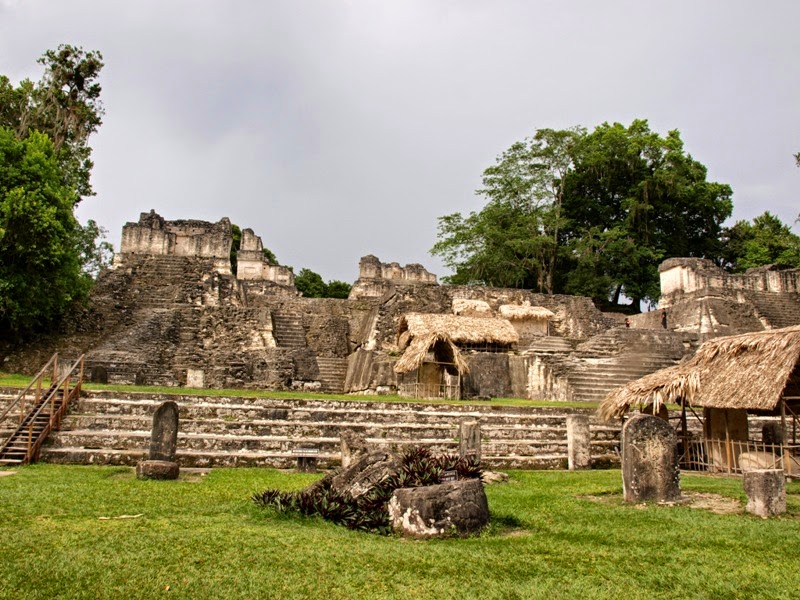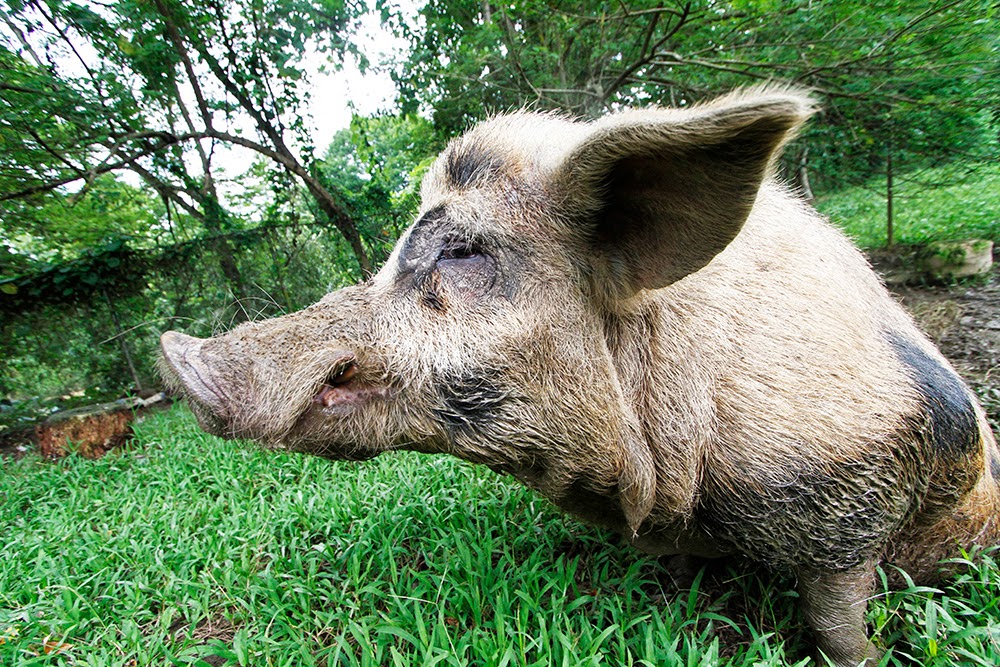Freddy the paraplegic pig.
There is no shortage of things to do
on the river. Jimi and I find ourselves going non-stop. By now we’ve met up
with most of our friends from French Harbour in Honduras, and we’ve made a
number of new friends since we’ve arrived. Now settled in, I’ll touch on some
of our highlights and what has also become routine for us.
We made another trip to the natural hot springs by
way of Guatemalan public transportation called a collectivo. There’s one thing
to remember about riding in a collectivo – there’s always room for one more.
We’ve heard there have been as many as thirty people in one of these twelve
passenger vans. We haven’t witnessed that, but we felt like we had on our way
to the springs. Thankfully we had seats, but six or seven people did not and
two of them were hovering over me. I held a bowl of corn for one lady while she
payed for her ride. A couple of road workers slide their machetes under my feet
as they stood for the ride. The van’s doorman took a seat on the van’s roof
when it became full.
We were the first ones to arrive at
the hot springs, which gave us ample time for some photos. But it wasn’t long before the tourists and some
locals piled in. The pond was clear and cool. The water falling from above is
warm. Over time the minerals in the spring water has created an overhang on the
rocks which allows visitors to gather under the overhang. If you can keep your
balance you can let the hot water hit your shoulders and slide down your back.
The small fish nibbled at my feet and ankles from time to time and I didn’t
like that.
The water is clear and calm.
An incredible peaceful place.
It really is this beautiful.
Under the rock ledge looking out.
Our selfie!
On the trail back to the road we met
up with some locals selling finger foods; even though we had no clue what it
was, we bought some and ate it. It was delicious. A family with several
children were working to collect fire
wood. The father carried two large tree logs on his back with the load on a
strap that went across the top of his head. Then he walked somewhat hunched
over down the trail. A young boy, looking about eight or nine was trying to
follow his father dragging a long cantankerous limb. We could see he was
struggling and yet, still trying his best to do the job. I picked up one end of
the log and motioned for him the pick up the other end. Together we carried the
limb down the trail until he said we’d reached the destination. I realized then
that the front of my shirt was covered in mud only in one precarious spot. I
couldn’t travel on the collectivo and through town like that, so I took my
shirt off and washed it in the river not far from another local doing her
laundry. There’s nothing like jumping in to the culture when you least expect
it.

The limb was heavier than it looks.
On a separate occasion we rode horses
through a non-profit organization called Freddy’s Friends. Freddy’s Friends was
started by a lady named Pam. Her and her husband moved here for Texas about six
years ago. To occupy her time, Pam rescues animals, spays and neuters cats and
dogs, deworms them and provides any medical attention needed. The money she
raises, by taking people horseback riding, helps pay for of all these things.
She has six rescued horses. All of which came to her underfed, overworked and
skinny. The most touching story is Freddy himself. Three years ago as Pam and
her girlfriend, Julia, were riding they came across a wee little piglet who’d
been hit by a car. The right side of his face was crushed, as well as most of
his body, but he was alive. Pam took him
home and began nursing him back to health. Now three years old, Freddy is fat
and happy. He’s roughly three hundred pounds and spoiled rotten with mud pits,
a swimming pool and lots of love. His
back legs never recovered, but that doesn’t stop him, he drags them behind him
wherever he goes. He loves people and all the attention he gets from the
visitors Pam brings. She has many other animals too: foxes, various cats, dogs,
iguanas and something that we’ve forgotten the name of.

Freddy posing for his picture.
This cat jumped on my shoulders and refused to leave.
The name of this animal escapes us.
One of the foxes.
One of Pam's dogs.
The horse barn.
The horse ride itself was easy going
and not at all a limited trail ride. We could gallop, go ahead or let lose if
we wanted to. We crossed swift flowing rivers, rode through rural villages
where children waved with big smiles upon their faces and stopped for a cola in
the village. We rode past pineapple fields and corn fields where the horses
tried to sneak a snack.
We took another collectivo to the
town of Morales with friends, Harry and Melinda. I had a large shopping list.
Unfortunately I didn’t find anything on it. Nevertheless, we walked, window
shopped, ate lunch and had ice cream. It was a enjoyable outing with friends.
We met a couple on vacation who
stayed in one of Captain John’s bungalows for two nights, Jon and Lynne. We
instantly hit it off and spent the weekend together including getting up at 6am
on Sunday to dinghy over to Monkey Bay. Monkey Bay is an area off the main
river covered in overhanging trees and brush. The floating vegetation is a
carpet on the water. Using our ores instead of the motor gave us an advantage
to find the howler monkeys. After more than 30 minutes of incognito stealthily
rowing following their loud calls, we found them. We weren’t
close enough to get great photos, but it was captivating all the same. When we were finished, we all retired to our
respective abodes and slept until noon. Jon and Lynn are continuing their vacation inland and will then head back
home to Jasper, Texas. We wish them well
and only regret that we didn’t have more time with them.
Howler monkey and baby.
Some of our daily and weekly rituals
include immersing ourselves in the swimming pool once and sometimes twice a day
to cool our cores and fruit and veggie shopping on Tuesdays and Saturdays. I
attend a bible study on Friday mornings, we listen to the net every morning,
except Sundays, at 7:30am and I do yoga in the mornings at 6:30ish with the
dock kitty, except I’m missed the past several days. A gathering to play Mexican train dominos is
Sunday afternoons – we’ve played once. Tonight we’re joining friends for a game
of trivia. We’ve sat in the pool with new friends John and Lisa and old friends
Harry and Melinda and dock neighbor Rich. We have more friends than we could
possibly mention without losing your interest. Trust me when I say there is no
shortage of friends, drop-ins and visiting.
The dock kitty doing yoga with me in the mornings.
Boat work – I try not to do any. Just
kidding. I do what I need to; daily cleaning, cooking and dishes. Jimi has made
us a nice drip tray mounted under the grill in the cockpit and took on a major
project to redesign the holding tank plumbing and engine exhaust hoses. He also
rebuilt a large manual pump used to empty the holding tank when at sea. He had
to get creative with the materials and make the parts from items he scavenged
at a local tire shop. The look on the
employee’s face clearly showed he thought Jimi was a loco gringo (crazy white
guy) when Jimi asked if he could rummage the trash pile and asked if he could
have the piece of inner tube he found.
I cook breakfast after the net , we
have a light lunch around noon and a smoothie in the afternoon daily. We try
not to cook in the evenings, but rather plan our menu ahead of time so we don’t
need to heat the cabin. We’ve found that it’s much more economical to buy local
foods for one of our meals each day. The restaurant, Sundog, sells a very large
sandwich called The Italian for $5. Loaded with three types of meat and veggies,
it’s large enough to share. About once a week we buy a roasted chicken. When
supplemented with steamed vegetable and rice or potatoes, it lasts us an easy
two meals. The food is unlimited and we’re still in awe at the amount of fruits
and vegetables, all fresh with smells that float through the city. The size of
the carrots and other vegetable is almost unbelievable. Our last purchase
included a bag of strawberries, a potato, a carrot, a bell pepper, two
jalapenos, two avocados, three tomatoes, green onions, three apples and a papaya
for $5. The prices are as well unbelievable.

This pile of fruit and vegetables cost us $3.25. The carrots are as large as, and often larger than, a banana.
Next week we begin some inland
travel. We’ll leave Sanibel for three days as we travel to the ruins of Tikal.
Stay tunned…





























































